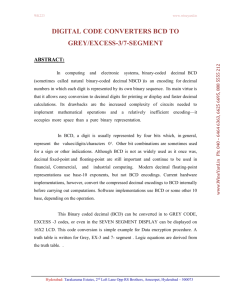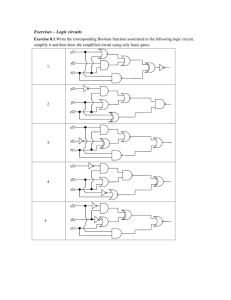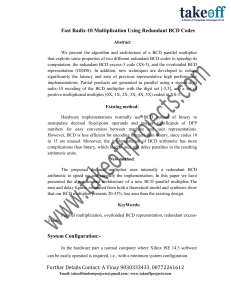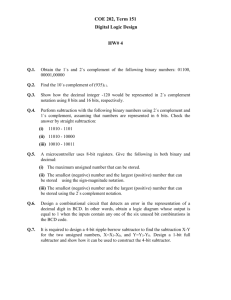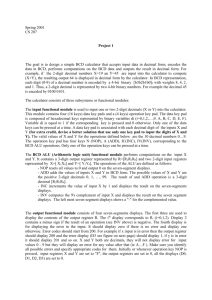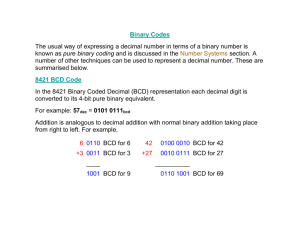Decimal multiplication
advertisement
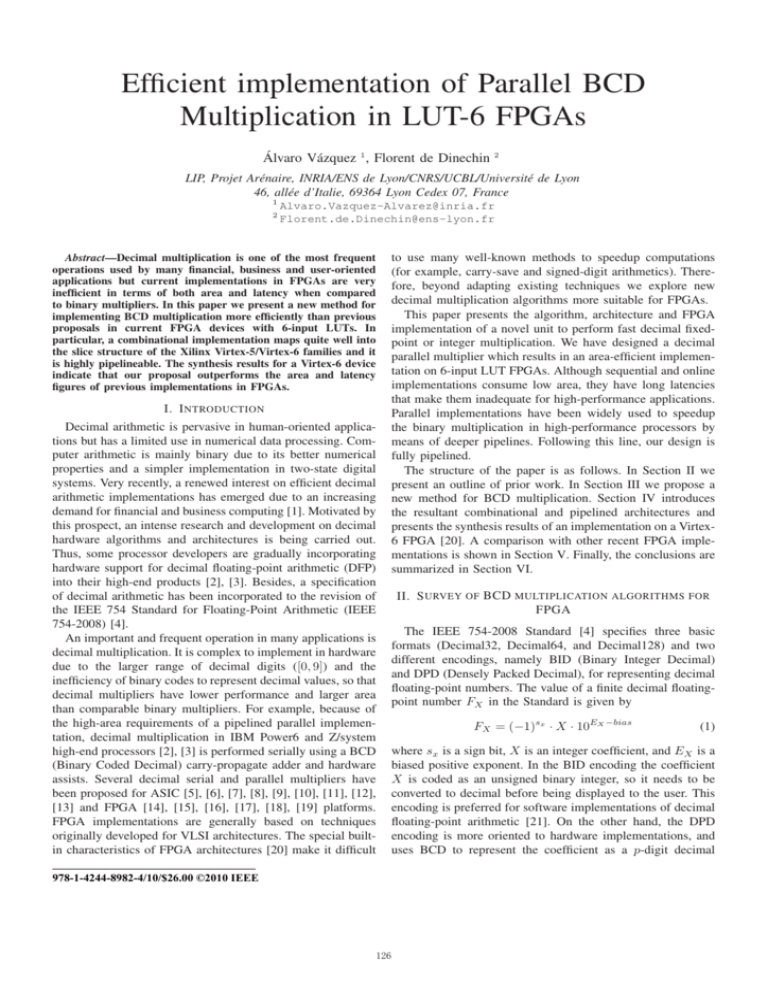
Efficient implementation of Parallel BCD
Multiplication in LUT-6 FPGAs
Álvaro Vázquez 1 , Florent de Dinechin 2
LIP, Projet Arénaire, INRIA/ENS de Lyon/CNRS/UCBL/Université de Lyon
46, allée d’Italie, 69364 Lyon Cedex 07, France
1
2
Alvaro.Vazquez-Alvarez@inria.fr
Florent.de.Dinechin@ens-lyon.fr
Abstract—Decimal multiplication is one of the most frequent
operations used by many financial, business and user-oriented
applications but current implementations in FPGAs are very
inefficient in terms of both area and latency when compared
to binary multipliers. In this paper we present a new method for
implementing BCD multiplication more efficiently than previous
proposals in current FPGA devices with 6-input LUTs. In
particular, a combinational implementation maps quite well into
the slice structure of the Xilinx Virtex-5/Virtex-6 families and it
is highly pipelineable. The synthesis results for a Virtex-6 device
indicate that our proposal outperforms the area and latency
figures of previous implementations in FPGAs.
I. I NTRODUCTION
Decimal arithmetic is pervasive in human-oriented applications but has a limited use in numerical data processing. Computer arithmetic is mainly binary due to its better numerical
properties and a simpler implementation in two-state digital
systems. Very recently, a renewed interest on efficient decimal
arithmetic implementations has emerged due to an increasing
demand for financial and business computing [1]. Motivated by
this prospect, an intense research and development on decimal
hardware algorithms and architectures is being carried out.
Thus, some processor developers are gradually incorporating
hardware support for decimal floating-point arithmetic (DFP)
into their high-end products [2], [3]. Besides, a specification
of decimal arithmetic has been incorporated to the revision of
the IEEE 754 Standard for Floating-Point Arithmetic (IEEE
754-2008) [4].
An important and frequent operation in many applications is
decimal multiplication. It is complex to implement in hardware
due to the larger range of decimal digits ([0, 9]) and the
inefficiency of binary codes to represent decimal values, so that
decimal multipliers have lower performance and larger area
than comparable binary multipliers. For example, because of
the high-area requirements of a pipelined parallel implementation, decimal multiplication in IBM Power6 and Z/system
high-end processors [2], [3] is performed serially using a BCD
(Binary Coded Decimal) carry-propagate adder and hardware
assists. Several decimal serial and parallel multipliers have
been proposed for ASIC [5], [6], [7], [8], [9], [10], [11], [12],
[13] and FPGA [14], [15], [16], [17], [18], [19] platforms.
FPGA implementations are generally based on techniques
originally developed for VLSI architectures. The special builtin characteristics of FPGA architectures [20] make it difficult
___________________________________
978-1-4244-8982-4/10/$26.00 ©2010 IEEE
126
to use many well-known methods to speedup computations
(for example, carry-save and signed-digit arithmetics). Therefore, beyond adapting existing techniques we explore new
decimal multiplication algorithms more suitable for FPGAs.
This paper presents the algorithm, architecture and FPGA
implementation of a novel unit to perform fast decimal fixedpoint or integer multiplication. We have designed a decimal
parallel multiplier which results in an area-efficient implementation on 6-input LUT FPGAs. Although sequential and online
implementations consume low area, they have long latencies
that make them inadequate for high-performance applications.
Parallel implementations have been widely used to speedup
the binary multiplication in high-performance processors by
means of deeper pipelines. Following this line, our design is
fully pipelined.
The structure of the paper is as follows. In Section II we
present an outline of prior work. In Section III we propose a
new method for BCD multiplication. Section IV introduces
the resultant combinational and pipelined architectures and
presents the synthesis results of an implementation on a Virtex6 FPGA [20]. A comparison with other recent FPGA implementations is shown in Section V. Finally, the conclusions are
summarized in Section VI.
II. S URVEY OF BCD MULTIPLICATION ALGORITHMS FOR
FPGA
The IEEE 754-2008 Standard [4] specifies three basic
formats (Decimal32, Decimal64, and Decimal128) and two
different encodings, namely BID (Binary Integer Decimal)
and DPD (Densely Packed Decimal), for representing decimal
floating-point numbers. The value of a finite decimal floatingpoint number FX in the Standard is given by
FX = (−1)sx · X · 10EX −bias
(1)
where sx is a sign bit, X is an integer coefficient, and EX is a
biased positive exponent. In the BID encoding the coefficient
X is coded as an unsigned binary integer, so it needs to be
converted to decimal before being displayed to the user. This
encoding is preferred for software implementations of decimal
floating-point arithmetic [21]. On the other hand, the DPD
encoding is more oriented to hardware implementations, and
uses BCD to represent the coefficient as a p-digit decimal
p−1
integer X = i=0 Xi 10i (p ∈ {7, 16, 34} for the three basic
formats). Each digit Xi is coded in BCD as
Xi =
3
xi,j · 2j
X
Y
4p
Signed-digit
Radix-10 recoder
p
Xs
Xm
Ys
j=0
where Xi ⊂ [0, 9] is the i decimal digit and xi,j ∈ {0, 1} is
the j th bit of the 4-bit BCD digit i.
In order to obtain an area-efficient FPGA implementation of
parallel decimal multiplication, we have first performed a survey of the most representative BCD multiplication algorithms.
A straightforward method to implement a BCD multiplication
P = X × Y in hardware is to use an existing binary
multiplier and conversions from BCD to binary and back
to BCD. Although these conversions are costly in terms of
latency and hardware resources, this solution was considered
by Vestias and Neto [19] for FPGAs with embedded binary
multipliers. To reduce the hardware cost, large multiplications
are subdivided in several 4 × 4-digit decimal multiplications,
each one implemented with two BCD to binary converters, an
embedded DSP block, and a binary to BCD converter.
These conversions can be avoided if the BCD operands are
multiplied directly. This typically involves two steps: generation and reduction of decimal partial products. These steps
can be implemented serially [6], [7], [9], [11] or in a parallel
fashion [5], [8], [10], [12], [13]. In serial implementations one
partial product is generated at each iteration, multiplying the
multiplicand by one digit of the multiplier, and accumulated
to the intermediate partial product. On the other hand, in
parallel implementations all partial products are generated
simultaneously and reduced in an array or tree structure of
adders.
Several FPGA implementations of BCD multipliers [14],
[15], [17], [18] adapt some techniques for decimal partial
product generation and reduction originally proposed for
ASIC. Sutter et al. [18] present combinational and sequential
implementations of BCD multipliers on a Xilinx Virtex-4
device. In this proposal, BCD input operands are multiplied
digit by digit in a binary way. Each 7-bit product is corrected
separately as proposed in [11] to form a two-digit BCD
product. These two-digit products are implemented in a Virtex4 FPGA using LUTs configured as multiplexers or 18-Kbit
RAM blocks. Pairs of decimal partial products are generated
in this way multiplying each BCD digit of the multiplier by the
multiplicand. All the partial products are then reduced using
a tree configuration of a specially designed fast BCD carrychain adder [22]. An extension of this architecture to decimal
floating-point multiplication was presented in [17].
A sequential BCD multiplier proposed in [6] for ASIC, has
been recently implemented by James et al. [15] on a variety
of FPGAs. In this approach, a set of simple BCD multiplicand
multiples ({0X, 1X, 2X, 4X, 5X}) are precomputed. Each
decimal partial product is generated sequentially by adding
two elements of this set, which are selected according to the
value of the corresponding BCD multiplier digit ([0, 9]). The
decimal partial products are accumulated to an intermediary
Ym
ysp-1
4p+1
7p+4
7p+4
7p+4
7p+4
PP[k] PP[k-1]
LUT-4
ysk-2
1
ysk
3
4
LUT-4
1
LUT-5
Input sign/magnitude digits in [-5,5]
Output sign/magnitude digits in [-25,25]
PP[p] PP[p-1]
1
Y0
4
LUT-4
ysp-2
1
Partial product generation
(digit by digit multiplications)
th
4
LUT-4
3p
Yk-1
Yk
4
Signed-digit
Radix-10 recoder
3p
p
(2)
Yp-1
4p
1
ysk-1
LUT-5
ys0
LUT-4
LUT-5
3
Magnitude
YMp-1
digits
[0,5]
1
YMk
[0,5]
3
3
YMk-1
[0,5]
YM0
[0,5]
PP[0]
PP[0]
(p+1) partial products
xsi ysp XMi syp-1
1
1
1
3
PP[k-1]
PP[k]
LUT-4
1
3
xsp ysp
pps[p]i
1
{0,1}
1
xsi ysk XMi YMk
PPM[p]i
[0,5]
1
1
3
3
LUT-6
1
pps[p]p
PP[p-1]
PP[p]
{0,1}
Figure 1.
1
6
pps[k]i
PPM[k]i
{0,1}
[0,25]
Signed-digit radix-10 recoding architecture
BCD partial product using a decimal carry-save 4:2 adder.
This adder can be build using two rows of 4-bit BCD carrypropagate adders.
Baesler and Teufel [14] implement a parallel BCD
multiplier on a Xilinx Virtex-II FPGA. This multiplier
is based on the methods proposed in [8], [12], [13],
namely, signed-digit radix-10 recoding of the BCD multiplier operand and pre-computation of decimal multiples
{−5X, . . . , −1X, 0X, 1X, . . . , 5X} for partial product generation, and decimal partial product reduction by means of a
special BCD-4221 carry-save adder tree.
McIlhenny and Ercegovac [16] present an implementation
of a decimal online floating-point multiplier onto a Virtex 5
FPGA. The multiplication is performed in digit-serial fashion,
obtaining a radix-10 digit of the result per cycle, with the most
significant digit first.
We finally considered a magnitude range reduction of the
BCD operand digits as the best way to simplify and speed-up
the generation of all the decimal partial product in parallel.
We compare the following two options: a signed-digit radix10 recoding (from [0, 9] to [−5, 5]) of both input operands
[7], and a signed-digit radix-5 recoding of the BCD multiplier
operand only [10], [12], [13]. We have mapped the different
proposals into 6-input LUTs and other available hardware on
a state-of-the-art FPGA slice.
A. Signed-digit radix-10 recoding of X and Y
In this case, the corresponding block diagram of the architecture is shown in Fig. 1. Every BCD (4-bit) input digit
is recoded between [−5, 5] in sign (1-bit) and magnitude (3bit) format. The recoded operands are multiplied digit by
digit, performing the multiplication of signs (logical XOR of
127
Xi
(X<<3)i
−1X, 1X or 2X. The hardware cost (p-digit operands) is
shown in column 3 of Table I, and is higher than the hardware
cost of the first scheme.
4
4
x5
10’s complement
x2
4
4
4
10’s complement
4
1-digit slice
5Xi
-Xi
2Xi
X
Yp-1
4p
Generation of
multiples
-X
2X
2p
-2X
LUT-4
2
3p
YL
YU
3
YUp-1YLp-1
4
LUT-4
2
Y0
Yk-1
Yk
4
4
Signed-digit
Radix-5 recoder
4(p+1)4(p+1) 4(p+1) 4(p+1)
5X
-2Xi
Y
4p
3
LUT-4
LUT-4
2
C. Partial product reduction
4
3
YUk YLk YUk-1YLk-1
{0,1,2} [-2,2]
2
3
YU0 YL0
Partial product generation
Output BCD digits in [0,9]
PPL[0]
PPU[0]
4p+4 4p+4
4p+4 4p+4
4p+4
PPU[p-1] PPL[p-1]
PPU[k] PPL[k]
PPU[0]PPL[0]
4p+4
2p partial products
-2X -X
X
0X
4p+4 4p+4
Mux-5
2X
4p+4 4p+4
3
YLp-1
4p+4
PPL[p-1]
PPU[p-1]
X
PPLp-1
PPL[k-1]
PPU[k-1]
PPL[k]
PPU[k]
<<4
10X
4p+4
0X
5X
4p+4
Mux-3
2
YUp-1
4p+4
PPUp-1
Figure 2.
Signed-digit radix-5 recoding architecture
sign bits) and magnitudes separately. The multiplication of
magnitudes requires 6-bit input lookup tables (LUT-6). The
digits of the decimal partial product array generated, shown
at the bottom of Fig. 1, are sign and magnitude numbers
between [−25, 25]. This results in 6 LUTs per digit-by-digit
multiplication since the partial product digit magnitudes are
represented in BCD. The hardware cost for p-digit BCD
operands is shown in column 2 of Table I.
B. Signed-digit radix-5 recoding of Y
Fig. 2 shows the block diagram for this case. Each BCD
digit Yk of the multiplier operand is recoded into two digits
as
Yk = 5 YkU + YkL
(3)
with YkU ∈ {0, 1, 2} and YkL ∈ {−2, −1, 0, 1, 2}. This
recoding needs five 4-input LUTs per digit (2 LUTs for YkU
and 3 LUTs for YkL ). Two partial products are generated per
BCD multiplier digit. The upper partial products are generated
as X ×YkU , while the lower partial products are X ×YkL , where
X the BCD multiplicand. In a straightforward implementation
[10], two BCD multiplicand multiples 2X and 5X are precomputed before partial product generation using combinational logic (each digit of a multiple generator can be mapped
into four LUT-4 or two LUT-6). Two negative multiples −X
and −2X are also pre-computed as the 9’s complement of
X and 2X respectively. Next, each upper partial product is
generated using a row of multiplexers controlled by YkU that
selects 5X or 10X. The 0X multiple is selected by a reset of
the output register. The lower partial products are generated
from digits YkL by selecting the correspondent multiple −2X,
However, before taking any decision about the preferred
design, we also have to take into account the significant
contribution of the partial product reduction to the total cost of
the multiplier. Faster parallel multipliers use multiple adders
connected in a tree configuration (O(log2 npp )) to reduce
the npp partial products generated into a final non-redundant
product. The number of partial products generated is roughly
doubled (npp = 2p instead of npp = p + 1) in the second case,
though all of them are BCD operands (digits in [0, 9]) instead
of signed-digit operands (digits in [−25, 25]).
The partial products generated by the scheme of Fig. 1
can be efficiently reduced using a decimal signed-digit adder
tree [7]. Besides, these partial products have to be converted
from [−25, 25] to an appropriate range for decimal signeddigit addition. A decimal signed-digit adder [23] reduces two
input digits (⊂ [−a, a] with a ∈ {5, 6, 7, 8, 9}) into a digit
in the same range, producing a transfer digit into the next
decimal position. This type of adders does not fit well in the
building blocks of current FPGAs, leading to tree structures
far from optimal in terms of area and delay. In Table I we
show the estimated complexity of decimal signed-digit adder
tree proposed by Erle et al. [7]. We use a first level of decimal
signed-digit adders for the conversion of partial product digits
from [−25, 25] to [−6, 6].
On the other hand, the reduction of the BCD partial products
generated by the scheme of Fig. 2 can be performed using a
variety of adders which can be mapped more efficiently on a
FPGA. Proposed implementations uses either carry-ripple or
carry-save adder trees. Decimal carry-save adder trees [5], [6],
[10], [13] require additional logic for decimal correction and
have much more interconnections which complicate the FPGA
implementation and routing. Lang and Nannarelli [10] use a
carry-save tree built of 4-bit BCD adders and 8-bit counters
to reduce the 2p BCD partial products generated. The result
of this reduction is a double word operand. The final BCD
product is obtained from the sum of these two terms in a BCD
carry-propagate adder. The estimated hardware cost of this
design is shown in Table I in terms of LUT-6. An alternative
is to implement a BCD carry-ripple adder tree [18] that can
make use of the dedicated fast carry chain. Its hardware cost,
shown in Table I, depends on how efficient are mapped these
BCD adders on FPGA. Fast FPGA implementations of BCD
carry-chain adders [22] require more than double the hardware
of an equivalent binary carry-ripple adder. Besides, since the
logic depth of these BCD adders is also doubled, the delay of a
tree implementation is incremented in a proportional amount.
To overcome both drawbacks, we designed a new BCD carryripple adder tree [24] that roughly halves the hardware cost
and latency of previous implementations.
128
Table I
H ARDWARE C OST OF BCD M ULTIPLIERS (p- DIGIT O PERANDS )
Ref. [7] (Fig. 1)
(# LUT-6)
8p
–
6p2 + 6p
p2 + 2p + 1 XORs
Signed-Digit†
Ref. [10] (Fig. 2)
(# LUT-6)
3p
8p
8p2 + 2p
Proposed (Fig. 3)
(# LUT-6)
3p
2p
8p2 + 2p
Recoding
Gen. of Multiples
Partial product
generation
Reduction Tree
Carry-Save‡
Carry-Ripple∗
Total:
p = 16 (16 × 16-digit mult) 10720 LUTs 289 XORs
7322 LUTs
4880 LUTs
p = 34 (34 × 34-digit mult)
46580 LUTs
31335 LUTs
21556 LUTs
p = 16 and p = 34 for IEEE 754-2008 decimal64 and decimal128 formats.
†
Signed-Digit Adder Tree: hcsd × (2p2 + p × (log2 p/2)) + hccra1 × 2p
‡
Carry-Save Adder Tree: hccra1 × (9p2 /4 + p × (log2 p + 3)/2) + 5p/8
∗
Carry-Ripple Adder Tree: hccra2 × (2p2 + p × (log2 p/2))
hcsd = 16 : Estimated hardware cost of a 1-digit decimal signed-digit adder [7], [23].
hccra1 = 8: Hardware cost of prior art 1-digit BCD carry-chain adder [22].
hccra2 = 5: Hardware cost of proposed 1-digit BCD carry-ripple adder [24].
X
Y
Yp-1
4p
4p
Signed-digit
Radix-5 recoder
x2
4p+1
2p
LUT-4
2
3p
YL
YU
4
LUT-4
2
3
Y0
Yj-1
Yj
4
4
3
4
LUT-4
LUT-4
2
3
2
3
yu0 yl0
yuj ylj yuj-1 ylj-1
yup-1 ylp-1
{0,1,2} [-2,2] {0,1,2} [-2,2] {0,1,2} [-2,2] {0,1,2} [-2,2]
Partial product generation
Output BCD digits in [0,9]
4p+4 4p+4
4p+4
4p+4
PPUp-1 PPLp-1
PPUi
4p+4
4p+4
PPLi PPU0
2p partial products
PPL0
Partial product reduction
Output BCD digits in [0,9]
8p
BCD ripple-carry adder tree
P
PPUp-1 PPLp-1
4p+4
PPUi
4p+4
4p+4
BCD carry-ripple adder
4p+4
PPLi
4p+4
4p+4
BCD carry-ripple adder
BCD carry-ripple adder
4p+4
BCD carry-ripple adder
4p+8
4p+8
PPU0
PPL0
4p+4
4p+4
BCD carry-ripple adder
4p+4
4p+4
4p+8
PPU0
PPL0
4p+4
BCD carry-ripple adder
4p+4
4p+4
BCD carry-ripple adder
4p+8
BCD carry-ripple adder
4p+16
4p+2p
4p+2p
log2 (p)+1 levels
BCD carry-ripple adder
8p
P
Figure 3.
Proposed BCD parallel multiplier
III. P ROPOSED METHOD
From the results of this survey, we opt for a parallel design
with a signed-digit radix-5 recoding of the BCD multiplier
Y and a BCD carry-ripple adder tree for partial product
reduction. The general block diagram of the proposed decimal
parallel multiplier is shown in Fig. 3. To improve the area
and performance of the resultant implementations we propose
a different organization of the basic scheme[10] that maps
better in a Xilinx Virtex-5/6 device (see hardware cost in
column 4 of Table I). In our case, only the 2X multiple is
precomputed. The remaining BCD multiplicand multiples are
computed on-the-fly in the BCD partial product generation
block. The decimal partial product generation is detailed in
Section III-A. We also have developed a new BCD carrypropagate addition algorithm [24], detailed in Section III-B,
that leads to an efficient decimal carry-ripple adder tree
implementation on a Xilinx Virtex-5/6 device (see hardware
cost in row 4 of Table I with hccra = 5). Moreover, since
it presents many similarities with a binary carry-ripple adder
tree, the partial product reduction tree can be pipelined using
existing techniques for binary [25]. The combinational and
pipelined BCD multipliers are presented in Section IV.
A. Partial product generation
We recode the BCD digits of Y using the signed-digit
radix-5 recoding described by Equation (3) in Section II-B.
129
8
Each 4-bit BCD digit Yk is recoded into an upper 2-bit
digit YkU ∈ {0, 1, 2} and a lower 3-bit signed-digit YkL ∈
{−2, −1, 0, 1, 2}. This recoding generates 2p partial products
aligned as shown in Fig. 2, that is, two BCD partial products
P P U [k] and P P L[k] per BCD digit Yk . The upper partial
product P P U [k] is computed from X and YkU as
⎧
if YkU == 2
⎨ 10X
10X/2 if YkU == 1
P P U [k] =
⎩
0X
if YkU == 0
(4)
xi,3 (2x)i,3
4
xi,2 (2x)i,2
2
xi,1 (2x)i,1
xi,0 (2x)i,0
1
1
1
3
1
3
1
LUT-6
pi,3
ppl[k]i,3
1
1
3
1
3
LUT-6
LUT-6
pi,2
pi,1
1
LUT-6
pi,0
gi,1
0
0
0
1
1
1
ppl[k]i,2
YLk
3
ppl[k]i,1
0
0
ppl[k]i,0
PPL[k]i
We have mapped this equation into a Virtex-5/6 FPGA slice.
Fig 4 shows the implementation of one BCD digit of P P U [k].
The LUTs implement the selection of digits (10X)i = Xi−1 ,
8
xi-1,3
10
xi,0
4
2
xi-1,2 xi-1,3
xi-1,1 xi-1,2
2
1
1
1
LUT-6
0
1
0
1
ppu[k]i,3
1
1
2
pi,1
gi,2
0
0
1
1
ppu[k]i,2
1
pi,0
0
YUk
PPU[k]i = (10X)i=Xi-1
YUk= 0
PPU[k]i = (0X)i= 0
Figure 4.
PPL[k]i =(Xi+10) mod16
YLk= -2
PPL[k]i =((2X)i+10) ) mod16
Figure 5.
xi,3 xi,2 xi,1 xi,0
1
+ 1
Generation of partial product P P L[k] at digit i
The 10’s complement of X is obtained by computing the 9’s
complement of each BCD digit Xi as
0
9 − Xi = (15 − Xi + 10) − 16 = (Xi + 10)
ppu[k]i,0
8
+
mod 16 (6)
and adding one bit to the least significant digit of P P L[k].
To avoid a large carry propagation in the partial product
generation, this bit is added in the partial product reduction
tree. The 9’s complement of Xi and (2X)i implies a 4bit carry-propagate addition implemented using the fast carry
logic of the Virtex-5/6 slice as shown in Fig. 5.
PPU[k]i
PPU[k]i = (5X)i= [Xi-1/2] + 5xi,0
PPL[k]i = 0
YLk = -1
1 2
0
ppu[k]i,1
YUk= 1
1
gi,0
1
YUk =
PPL[k]i = Xi
k=
LUT-6
LUT-6
LUT-6
pi,2
pi,3
1 2
PPL[k]i = (2X)i
YL
YLk= 0
1
xi-1,0 xi-1,1
2
YLk= 2
4
2
1
xi-1,3 xi-1,2 xi-1,1
xi,0
xi,0
Generation of partial product P P U [k] at digit i
B. Partial product reduction
(5X)i or 0. The BCD multiple 10X is obtained at no cost
by shifting the multiplicand X 4 bits to the left. The multiple
5X is computed dividing 10X by 2, that is, each digit of
5X is given by (5X)i = Xi−1 /2 + xi,0 5. This division
is implemented as a 1-bit right shift of 10X followed by a
conditional addition of 5 (BCD value 0101) at digit i when
xi,0 is one. This 4-bit addition is implemented using the fast
carry logic of the Virtex-5/6 slice.
The k − th lower partial product P P L[k] is computed from
2X, X and YkL as
⎧
2X
if YkL == 2
⎪
⎪
⎪
⎪
if YkL == 1
⎨ 1X
0X
if YkL == 0
P P L[k] =
⎪
p
⎪
if YkL == −1
10 − X
⎪
⎪
⎩ p
10 − 2X if YkL == −2
(5)
In Fig. 5 we show the implementation of this equation into the
Virtex-5/6 slice for one digit. Only the multiples X and 2X are
pre-computed. A negative partial product is obtained by computing on demand the 10’s complement of the corresponding
positive multiple (that is, by the 10’s complement of X if
YKL = −1, and by the 10’s complement of 2X if YKL = −2).
The 2p partial products generated are aligned and reduced
using the tree of carry-ripple adders of Fig. 3. It has log2 (2p)
levels of carry-ripple adders ranging from 4p + 4-bit to 6p-bit
length. The result of each two-operand BCD sum is passed to
an adder a level down, and the carry ripples through the length
of the adder. However, since the carry-ripple chains overlap,
the signals are propagated as much as 8p bits in length plus
log2 (2p) levels in depth. Therefore, the critical path delay of
this tree is given by
tppr = tc−path × 2p + ts−path × (log2 (2p) − 1)
(7)
where tc−path is the delay of the carry chain of a 1-digit (4-bit)
BCD adder and ts−path the delay of the sum path of the 1-digit
BCD adder. Bioul et al. [22] proposed several decimal adders
that use the fast carry chain of the Virtex-6 slice to speedup
a two-operand BCD addition. The implementation with the
lowest hardware cost is shown in Fig. 6. In this design, the
decimal carries are obtained by a direct implementation of
a decimal carry-propagate recurrence Ci+1 = Gi ∨ Pi Ci .
Boolean signals Gi and Pi indicate the conditions for the
generation and propagation of decimal carries for each digit,
and are true when the binary sum of the input digits Zi =
Xi + Yi is higher than 9 or equal to 9 respectively. When a
130
xi,3
1
yi,3
xi,2
1
yi,2
1
0
1
0
0
0
0
1
1
1
LUT-6
Gi
pi,3
Ci
LUT-6
LUT-6
pi,2
pi,1
gi,2
0
LUT-6
0
0
1
1
1
Ci
si,1 (2)
except when Zi ∈ {14(1110), 15(1111)}. In this case, the +6
factor has been added in excess and the correct BCD sum
digits are Si ∈ {8(1110), 9(1001)}. To avoid corrections between levels of the adder tree, we allow the 4-bit combinations
(1110), (1111) to be valid representations of decimal values 8
and 9. Only the output digits Zi of the adder tree are corrected
as
(8)
Pi = zi,3 8 + (zi,2 zi,3 ) 4 + (zi,1 zi,3 ) 2 + zi,0
si,0 (1)
XUi = x i,3 8 + xi,2 4 + xi,1 2
YUi = y i,3 8 + yi,2 4 + yi,1 2
3
xi,0
1
LUT-6
gU
i
Ci+1
yi,0
LUT-6
LUT-6
LUT-6
pi,3
pi,2
pi,1
pi,0
0
1
1
0
0
gi,0
0
0
Ci
1
1
to obtain the digits Pi of the final BCD product using two 1-bit
flip-flops of the Virtex-5/6 slice configured as two logical AND
gates with an inverted input. With this method, the equivalent
hardware cost of 1-digit BCD adder is reduced to 5 LUTs per
digit and tc−path , ts−path are roughly the delays of the carry
and sum paths of a 4-bit binary carry-ripple adder.
1
LUT-6
0
Delay
(ns)
4.91
5.17
6.41
6.90
8.38
9.48
14.39
0
BCD Carry-Chain Adder (1-digit). Prior Art [22]
3
Hardware Cost
(# LUT-6)
336
642
1268
2396
4880
10010
21611
pi,0
gi,1
0
si,2 (4)
zi,0 (1)
1
zi,1 (2)
1
BCD Mult. size
(pX × pY )
4×4
8×4
8×8
16 × 8
16 × 16
34 × 16
34 × 34
pzi,0 gzi,0
zi,4 (16) 1
si,3 (8)
Figure 6.
LUT-6
pzi,2 gzi,2 pzi,1 gzi,1
zi,2 (4)
Table II
S YNTHESIS R ESULTS FOR THE C OMBINATIONAL I MPLEMENTATION
1
LUT-6
pzi,3 gzi,3
1
yi,0
xi,0
1
1
LUT-6
LUT-6
Ci+1
yi,1
LUT-6
1 zi,3 (8)
Pi
xi,1
1
1
IV. PARALLEL BCD M ULTIPLIERS
si,3
8
Figure 7.
si,2
4
si,1
2
si,0
1
Proposed BCD Carry-Ripple Adder (1 digit)
decimal carry-out Ci+1 is produced, the binary sum must be
corrected by 6 (0110) to obtain the BCD sum digit Si , that is
Si = Zi + 6 Ci+1 + Ci . The problem of this design is its high
hardware cost, equivalent to eight LUT-6, and that ts−path is
more than double the delay of a 4-bit binary carry-ripple adder,
because the sum path goes through two successive levels of
LUT-6 separated by the global routing.
We propose a different method for BCD carry-propagate
addition [24] that lead to the implementation of Fig. 7. In this
method, a correction factor of 6 (0110) is added to the BCD
input digits Xi , Yi when the sum XiU + YiU is equal or higher
than 8. We denote by XiU , YiU the 3 most significant bits
of Xi and Yi respectively. This conditional addition of 6 is
merged with the binary addition of Xi + Yi + Ci using the
Virtex-5/6 slice configuration of Fig. 7. Another boolean signal
giU , which indicates when XiU + YiU ≥ 10, is computed in a
fifth LUT-6. In this way, the decimal carries Ci+1 are obtained
from a single binary carry-propagate addition of the modified
BCD input operands. The BCD sum digit Si is equal to the
4-bit binary sum
(Xi + Yi + 6 + Ci ) mod 16 if XiU + YiU ≥ 8
Zi =
else
(Xi + Yi + Ci ) mod 16
131
Combinational and pipelined versions of the proposed parallel BCD multiplier were designed in VHDL for arbitrary
px ×py -digit wide multiplications using the Xilinx ISE Design
Suite 11.4. The basic building blocks of the multiplier were
instantiated into components of the Xilinx Virtex-6 library to
have more control over the mapping process. The architectures
were synthesized in a Virtex-6 XC6VLX75T device with speed
grade-3 using the XST compiler and simulated with Modelsim
SE 6.5.
A. Combinational Architecture
We have synthesized the combinational BCD multiplier of
Fig. 3 for different operand sizes. A 16 × 16-digit BCD multiplier is required for the multiplication of BCD significands
in the IEEE Decimal64 format. For the IEEE Decimal128
format, the BCD multiplication size supported must be 34×34.
Besides, we have included several rectangular multipliers in
this list. The area and delay synthesis results are presented in
Table II.
The hardware cost is expressed in terms of equivalent LUT6 units and the delay in ns.
B. Pipelined Architecture
We consider a 2-stage pipeline for the multiplicand recoding
and generation of partial product. We place each level of the
adder tree in a different pipeline stage. Besides, each carryripple adder is pipelined in chunks of m bits at most. The total
number of pipelined stages is equal to 2+8p/m+log2 (p). In
PPU[0] PPL[0]
4
4
p
p
16-bit
Shift
Register
LUTs
4p+4
p
p
p
p
p
p
4
p
p
p
p-4
p
p
p
16
p
p
p
p
p
16
p
p
8
4p+16
p
4
8
4p+8
p
p
p
p
p
p
p
6 with speed grade -3, though these figures are difficult to
extrapolate to Virtex-4 for a fair comparison with [19]. To
give a notion of how Virtex-4 and Virtex-6 implementations
could compare, we show in Table IV the area and latency
figures of a 53×53-bit binary multiplier provided by the Xilinx
Core generator. Virtex-6 performance is practically doubled
compared to Virtex-4 due to feature size reduction of the
underlying VLSI technology. These results are shown in Table
IV.
Although in terms of area both implementations are comparable, our 16 × 16 BCD combinational multiplier is more than
7 times faster than any of the designs presented by Vestias
and Neto [19].
Sutter et al. [18] reported results for combinational implementations of BCD multipliers up to 32 × 16 digits.
The 16 × 16 BCD multiplier has a latency of 26.9 ns and
occupies 22033 LUTs on a Virtex-4 with speed grade -11.
Again, a direct comparison of this implementation with our
Virtex-6 implementation is quite unfair. However, we observe
that the reduction in latency is more than 3 times between
the implementation of Sutter et al. [18] (Virtex-4) and our
combinational multiplier (Virtex-6). For hardware cost, the
reduction is around a factor of 4.5. Therefore, these significant
improvements cannot be explained only by the use different
implementation technologies. We have also included in this
Table the synthesis results of a 16×16 BCD multiplier reported
by Baesler et al. [14] in a Virtex-II Pro XC2VP30 with speed
grade -6.
4p+4
4p+4
4
p-4
p-8
8
p-8
p
p
p
p
6p
2p
p
p
p
p
p
p
8p
P
Path with maximum
number of pipeline stages
VI. C ONCLUSION AND FUTURE WORK
Figure 8. Detail of a pipelined 16 × 16-digit BCD Multiplier (m = p = 16)
Fig. 8 we show this register placement for the least significant
part of the partial product reduction tree of a 16 × 16-digit
BCD multiplier and m = p = 16. A significant amount of
registers is required for input synchronization [25]. To reduce
the hardware cost, these synchronization registers are placed
in the first pipeline level of the tree and packed together as
16-bit shift register LUTs.
We have pipelined in this way the 16 × 16 BCD parallel
multiplier and implemented for different values of m. The
synthesis results are presented in Table III.
V. C OMPARISON
We compare our synthesis results with three different parallel implementations of decimal multiplication on FPGAs
recently reported [14], [18], [19]. Vestias and Neto [19] present
results for 8 × 8-digit and 16 × 16-digit multipliers in a Virtex4 SX35-12 FPGA. These designs can make use of embedded
binary multipliers to reduce the number of utilized LUTs.
Their 16 × 16 multiplier uses 16 embedded DSP blocks and
3005 LUTs with a delay of 68 ns, or equivalently 6493 LUTs
with a delay of 65 ns.
On the other hand, our combinational 16 × 16 multiplier
has a cost of 4880 LUTs and a latency of 8.38 ns on Virtex-
132
In this work we presented the design of a BCD multiplier
and its implementation on a Virtex-5/6 FPGA. We performed
a survey of prior techniques of BCD multiplication to find
the most adequate for low-latency area-efficient FPGA implementations. The proposed architecture is based on a parallel
generation of the decimal partial products using a signeddigit radix-5 recoding of the multiplier operand. The partial
product reduction is performed in a tree of BCD carryripple adders. We developed new methods for an efficient
implementation of both generation and reduction techniques
on the Virtex-5/6 slice. Combinational and pipelined versions
of the BCD multiplier were synthesized in a Virtex-6 speed
grade-3 device and the results compared with those of three
recent FPGA implementations of parallel BCD multipliers. We
show that the proposed design is a very competitive option
for high-performance low-latency implementations of BCD
multiplication on Virtex-5/6 FPGAs at a moderate hardware
cost.
Future work includes the extension of the proposed BCD
multiplier architectures to decimal floating-point. Also, we are
planning to integrate the proposed multiplier in a core of the
FloPoCo project1 , a generator of arithmetic cores for FPGAs,
and to support more FPGA targets than Virtex-5/6 families.
1 http://www.ens-lyon.fr/LIP/Arenaire/Ware/FloPoCo/
Table III
S YNTHESIS RESULTS FROM PIPELINING OF THE 16 × 16 BCD MULTIPLIER
m
(bits)
64
32
16
8
#pipe.
stages
8
10
14
22
Clock Freq.
(Mhz)
453 Mhz
579 Mhz
672 MHz
731 Mhz
Delay
latency× #stages
17.7 ns (2.21 × 8)
17.2 ns (1.72 × 10)
20.9 ns (1.49 × 14)
30.1 ns (1.37 × 22)
Hardware
#LUT-6
5008
6032
6544
6800
Cost
#FF
6926
6957
7020
7148
Table IV
C OMPARISON OF 16 × 16 BCD M ULTIPLIERS
Design
Combinational
Pipelined (8-stage)
Virtex-6 53 × 53-bit Binary Mult.
Vestias et al. w/DSP [19]
Vestias et al. wo/DSP [19]
Sutter et al. [18]
Virtex-4 53 × 53-bit Binary Mult.
Baesler et al. [14] (Virtex-II Pro)
Delay
(ns)
8.4 ns
17.7 ns (8@453 Mhz)
26.6 ns (12@450 Mhz)
68 ns
65 ns
26.9 ns
45 ns (18@400 Mhz)
54 ns (6@111 Mhz)
ACKNOWLEDGMENT
The authors would like to thank Bogdan Pasca for his
valuable help and many interesting suggestions throughout the
preparation of this paper.
R EFERENCES
[1] M. Cowlishaw, “Decimal floating-point: Algorism for computers,” in
Proc. 16th IEEE Symposium on Computer Arithmetic (ARITH16), Santiago de Compostela, Spain, Jul. 2003, pp. 104–111.
[2] L. Eisen et al., “IBM POWER6 accelerators: VMX and DFU,” IBM
Journal Research and Development, vol. 51, no. 6, pp. 663–684, Nov.
2007.
[3] E. Schwarz, J. Kapernick, and M. Cowlishaw, “Decimal floating-point
support on the IBM System z10 processor,” IBM Journal Research and
Development, vol. 51, no. 1, pp. 4:1–4:10, Jan./Feb. 2009.
[4] IEEE Std 754(TM)-2008, IEEE Standard for Floating-Point Arithmetic,
IEEE Computer Society Std., Aug. 2008.
[5] L. Dadda and A. Nannarelli, “A variant of a radix-10 combinational
multiplier,” in Proc. IEEE Int. Symposium in Circuits and Systems
(ISCAS 2008), Santiago de Compostela, Spain, May 2008, pp. 3370–
3373.
[6] M. A. Erle and M. J. Schulte, “Decimal multiplication via carry-save
addition,” in Proc. of the IEEE International Conference on ApplicationSpecific Systems, Architectures, and Processors (ASAP 2003), The
Hague, The Netherlands, Jun. 2003, pp. 348–358.
[7] M. A. Erle, E. M. Schwarz, and M. J. Schulte, “Decimal multiplication
with efficient partial product generation,” in Proc. 17th IEEE Symposium
on Computer Arithmetic (ARITH17), Cape Cod, MA, USA, Jun. 2005,
pp. 21–28.
[8] B. J. Hickman, A. Krioukov, M. A. Erle, and M. J. Schulte, “A
parallel IEEE P754 decimal floating-point multiplier,” in Proc. 25th
IEEE Conference on Computer Design (ICCD’07), Lake Tahoe, CA,
USA, Oct. 2007, pp. 296–303.
[9] R. D. Kenney, M. J. Schulte, and M. A. Erle, “High-frequency decimal
multiplier,” in Proc. 2004 IEEE International Conference on Computer
Design: VLSI in Computers and Processors (ICCD 2004), San Jose, CA,
USA, Oct. 2004, pp. 26–29.
[10] T. Lang and A. Nannarelli, “A radix-10 combinational multiplier,” in
Proc. 40th Asilomar Conference on Signals, Systems, and Computers,
Pacific Grove, CA, USA, Oct. 2006, pp. 313–317.
[11] G. Jaberipur and A. Kaivani, “Binary-coded decimal digit multipliers,”
IET Comput. Digit. Tech., vol. 1, no. 4, pp. 377–381, Jul. 2007.
Hardware Cost
(# components)
4880 LUT
5008 LUT 6926FF
150LUT-FF 133LUT 276FF 10DSP
3005 LUT 16 DSP
6493 LUT
22033 LUT
279Slices 386LUT 437FF 16DSP
5289 LUT
[12] A. Vazquez, E. Antelo, and P. Montuschi, “A new family of highperformance parallel decimal multipliers,” in Proc. 18th IEEE Symposium on Computer Arithmetic (ARITH18), Montpellier, France, Jun.
2007, pp. 195–204.
[13] ——, “Improved design of high-performance parallel decimal multipliers,” IEEE Trans. Comput., vol. 59, no. 5, pp. 679–693, May 2010.
[14] M. Baesler and T. Teufel, “Fpga implementation of a decimal floatingpoint accurate scalar product unit with a parallel fixed-point multiplier,”
in Proc. IEEE International Conference on Reconfigurable Computing
and FPGAs 2009 (ReConFig’09), Cancun, Mexico, Dec. 2009, pp. 6–11.
[15] R. James, K. Jacob, and S. Sasi, “Performance analysis of double
digit decimal multiplier on various FPGA logic families,” in Proc. V
Southern Programmable Logic Conference (SPL09), Sao Carlos, Brazil,
Apr. 2009, pp. 165–170.
[16] R. McIlhenny and M. Ercegovac, “On the design of a radix-10 online
floating-point multiplier,” in Proc. SPIE on Advanced Signal Processing
Algorithms, Architectures, and Implementations, San Diego, CA, USA,
Aug. 2009.
[17] C. Minchola and G. Sutter, “A FPGA IEEE 754-2008 Decimal64
floating-point multiplier,” in Proc. IEEE International Conference on
Reconfigurable Computing and FPGAs 2009 (ReConFig’09), Cancun,
Mexico, Dec. 2009, pp. 59–64.
[18] G. Sutter, E. Todorovich, G. Bioul, M. Vazquez, and J.-P. Deschamps,
“FPGA implementations of BCD multipliers,” in Proc. IEEE International Conference on Reconfigurable Computing and FPGAs 2009
(ReConFig’09), Cancun, Mexico, Dec. 2009, pp. 36–41.
[19] M. P. Vestias and H. C. Neto, “Parallel decimal multipliers using binary
multipliers,” in VI Southern Programmable Logic Conference, (SPL
2010), Ipojuca, Brazil, Mar. 2010, pp. 73–78.
[20] “Virtex-6 configurable logic block user guide,” http://www.xilinx.com/,
Xilinx Inc., Sep. 2009.
[21] M. Cornea, J. Harrison, C. Anderson, P. T. P. Tang, E. Schneider, and
E. Gvozdev, “A software implementation of the IEEE 754R decimal
floating-point arithmetic using the binary encoding format,” IEEE Trans.
Comput., vol. 58, no. 2, pp. 148–162, Feb. 2009.
[22] G. Bioul, M. Vazquez, J.-P. Deschamps, and G. Sutter, “Decimal
addition in FPGA,” in Proc. V Southern Programmable Logic Conference(SPL09), Sao Carlos, Brazil, Apr. 2009, pp. 101–108.
[23] A. Svoboda, “Decimal adder with signed-digit arithmetic,” IEEE Trans.
Comput., vol. C, pp. 212–215, Mar. 1969.
[24] A. Vazquez and F. de Dinechin, “Multi-operand decimal tree adders for
FPGAs,” INRIA, Research Report, Sep. 2010.
[25] F. de Dinechin, H. D. Nguyen, and B. Pasca, “Pipelined FPGA
adders,” École Normale Supérieure de Lyon, LIP Research Report ensl00475780, Apr. 2010.
133
